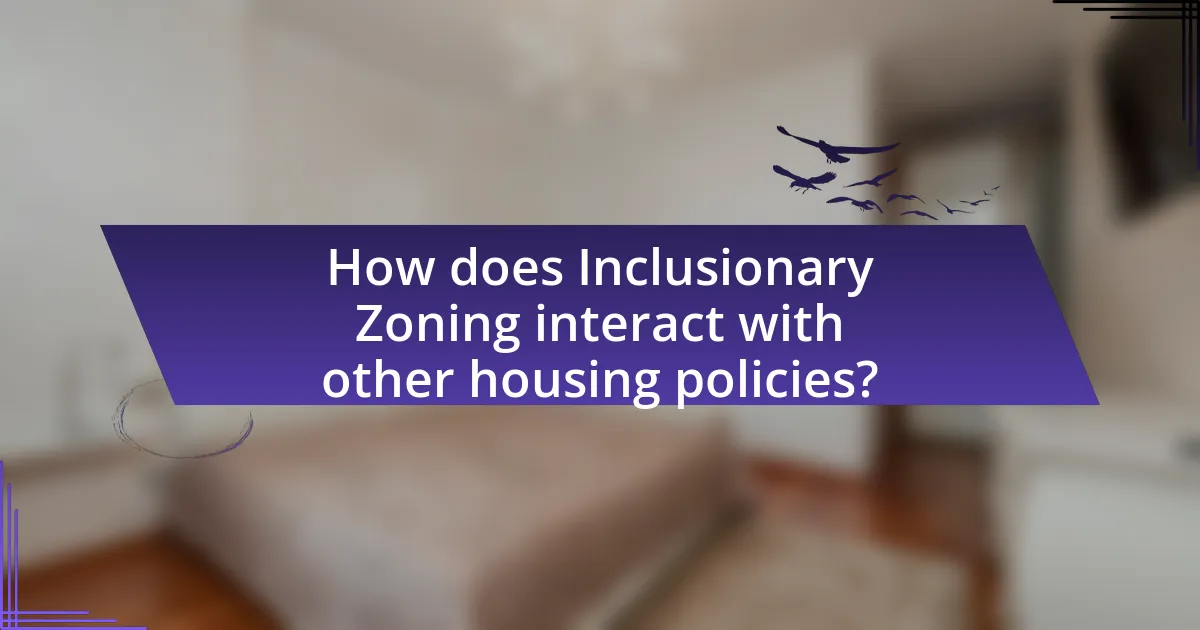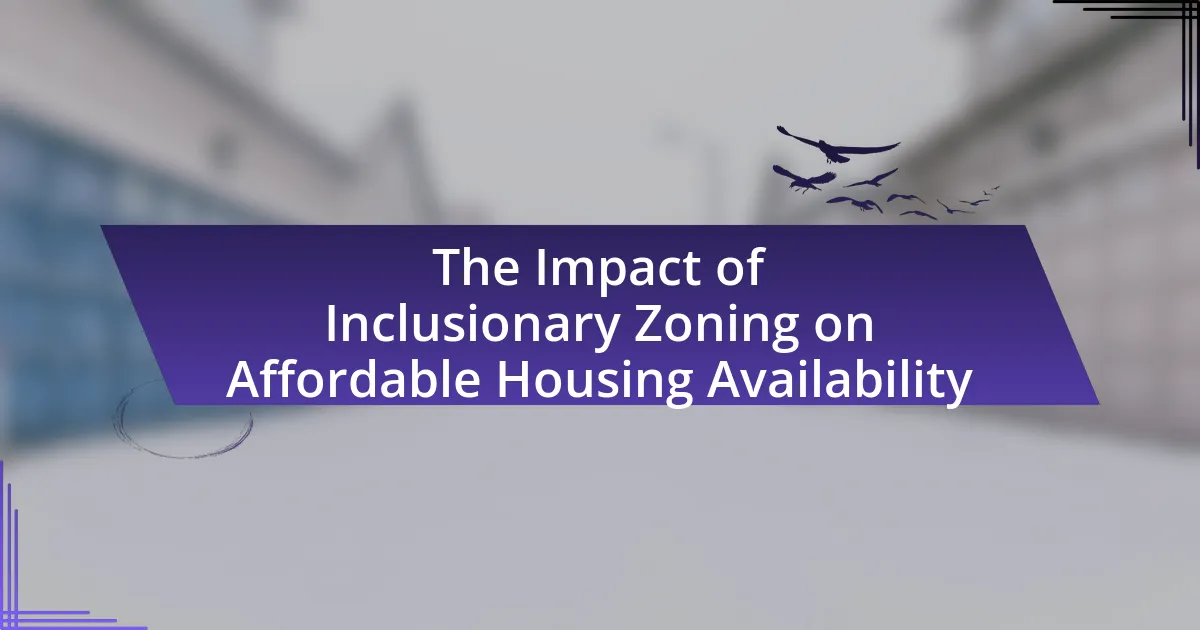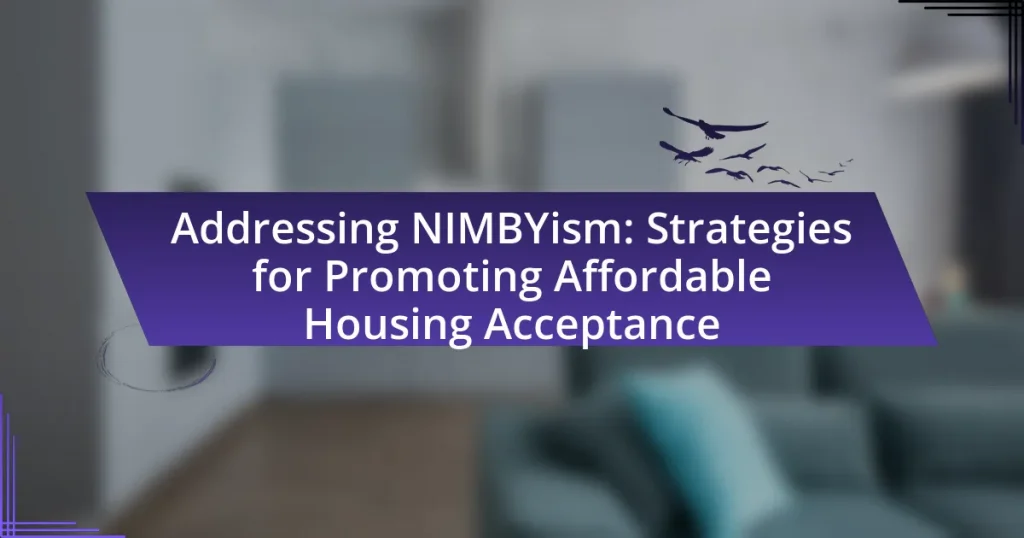Inclusionary zoning is a land-use policy designed to increase the availability of affordable housing by requiring developers to allocate a percentage of new residential units for low- and moderate-income households. This article examines the purpose and principles of inclusionary zoning, its implementation across various jurisdictions, and the potential benefits and challenges it presents. Key topics include the impact on community diversity, economic implications for local markets, and the interaction with other housing policies. Additionally, the article explores best practices for enhancing the effectiveness of inclusionary zoning and metrics for evaluating its success in addressing affordable housing shortages.

What is Inclusionary Zoning and its Purpose?
Inclusionary zoning is a land-use policy that requires or incentivizes developers to include a certain percentage of affordable housing units in new residential developments. The purpose of inclusionary zoning is to promote affordable housing availability within communities, ensuring that a mix of income levels can reside in the same area. This policy aims to combat housing segregation and provide low- and moderate-income families access to housing in desirable neighborhoods, thereby fostering economic diversity and stability. Studies have shown that inclusionary zoning can increase the stock of affordable housing, with some jurisdictions reporting a significant percentage of new units being designated as affordable through such policies.
How does Inclusionary Zoning aim to increase affordable housing availability?
Inclusionary Zoning aims to increase affordable housing availability by requiring developers to include a percentage of affordable units in new residential projects. This policy incentivizes the creation of affordable housing by allowing developers to benefit from density bonuses, reduced parking requirements, or expedited permitting processes in exchange for providing affordable units. For instance, cities like San Francisco and New York have implemented Inclusionary Zoning policies that mandate a specific percentage of units in new developments be set aside for low- and moderate-income households, thereby directly increasing the stock of affordable housing in high-demand areas.
What are the key principles behind Inclusionary Zoning policies?
Inclusionary Zoning policies are primarily based on the principles of promoting affordable housing, ensuring equitable access to housing, and integrating diverse income levels within communities. These policies require developers to include a certain percentage of affordable units in new residential projects, thereby increasing the overall supply of affordable housing. Research indicates that cities implementing Inclusionary Zoning have seen a measurable increase in affordable housing stock; for example, San Francisco’s Inclusionary Zoning program resulted in the creation of over 1,500 affordable units between 2005 and 2015. This approach not only addresses housing shortages but also fosters social diversity and community cohesion by mixing various income groups within the same neighborhoods.
How do different jurisdictions implement Inclusionary Zoning?
Different jurisdictions implement Inclusionary Zoning by establishing policies that require a percentage of new residential developments to be affordable for low- to moderate-income households. For example, San Francisco mandates that 12-20% of units in new developments be affordable, while New York City requires 25-30% in certain areas. These policies often include incentives such as density bonuses or tax breaks to encourage developers to comply. Research indicates that jurisdictions with robust Inclusionary Zoning policies can significantly increase the availability of affordable housing, as seen in cities like Montgomery County, Maryland, where over 13,000 affordable units have been created since the program’s inception.
What are the potential benefits of Inclusionary Zoning?
Inclusionary zoning can increase the availability of affordable housing by requiring developers to include a percentage of affordable units in new residential projects. This policy helps to create mixed-income communities, which can enhance social diversity and reduce economic segregation. Studies have shown that cities implementing inclusionary zoning have seen a rise in affordable housing stock; for example, San Francisco’s inclusionary housing program resulted in over 1,500 affordable units being built between 2002 and 2015. Additionally, inclusionary zoning can provide financial incentives for developers, such as density bonuses, which can make projects more economically viable while addressing housing shortages.
How does Inclusionary Zoning contribute to community diversity?
Inclusionary Zoning contributes to community diversity by mandating a percentage of affordable housing units within new developments, thereby integrating low- and moderate-income residents into various neighborhoods. This policy fosters socioeconomic diversity, as it allows individuals from different income levels to coexist in the same community, reducing economic segregation. For instance, cities like San Francisco and New York have implemented Inclusionary Zoning, resulting in a more diverse population mix and improved access to resources for lower-income families. Studies indicate that such integration can enhance social cohesion and provide equitable access to amenities, ultimately enriching the community fabric.
What economic impacts can Inclusionary Zoning have on local markets?
Inclusionary Zoning can lead to increased affordable housing availability, which positively impacts local markets by stabilizing housing prices and promoting economic diversity. By mandating that a percentage of new developments be set aside for affordable units, Inclusionary Zoning helps to mitigate the effects of gentrification, allowing lower-income residents to remain in their communities. Studies, such as those conducted by the Urban Institute, indicate that areas with Inclusionary Zoning policies often experience a slower rise in overall housing costs compared to areas without such regulations, thereby enhancing market stability and accessibility for a broader demographic.

What challenges does Inclusionary Zoning face?
Inclusionary Zoning faces several challenges, including opposition from developers, legal constraints, and market conditions. Developers often resist Inclusionary Zoning policies due to concerns about reduced profitability and increased construction costs, which can lead to a decrease in overall housing supply. Legal challenges arise when these policies are perceived as regulatory overreach, potentially leading to court battles that can delay or invalidate such initiatives. Additionally, fluctuating market conditions can undermine the effectiveness of Inclusionary Zoning, as economic downturns may reduce the demand for new housing, making it difficult to achieve the intended affordable housing outcomes. These factors collectively hinder the successful implementation of Inclusionary Zoning as a tool for increasing affordable housing availability.
How do developers respond to Inclusionary Zoning regulations?
Developers typically respond to Inclusionary Zoning regulations by adjusting their project designs and financial strategies to comply with the mandated affordable housing requirements. This often includes increasing the overall density of their projects to offset the costs associated with providing affordable units, as seen in cities like San Francisco, where developers have been known to build more units than initially planned to meet these regulations. Additionally, some developers may seek to negotiate for fee waivers or alternative compliance options, such as contributing to a housing fund instead of including affordable units on-site, which has been documented in various urban studies.
What are the common objections raised by developers regarding Inclusionary Zoning?
Developers commonly object to Inclusionary Zoning due to concerns about increased costs, reduced profitability, and potential market distortions. They argue that the requirement to include affordable units can lead to higher construction expenses, which may deter investment in new projects. Additionally, developers claim that these regulations can limit the overall supply of housing by making projects financially unviable, ultimately exacerbating housing shortages. Studies, such as those conducted by the Urban Institute, indicate that Inclusionary Zoning can lead to a decrease in overall housing production, as developers may opt to build in areas without such requirements to maintain profitability.
How can Inclusionary Zoning affect housing supply and market dynamics?
Inclusionary zoning can increase affordable housing supply while influencing overall market dynamics by mandating that a percentage of new developments be set aside for low- and moderate-income households. This policy can lead to a greater availability of affordable units, as seen in cities like San Francisco, where inclusionary zoning has contributed to the creation of thousands of affordable homes since its implementation. Additionally, by integrating affordable units within market-rate developments, inclusionary zoning can promote socioeconomic diversity and stabilize neighborhoods, which can mitigate displacement pressures and enhance community cohesion. Studies indicate that such policies can also impact housing prices by increasing the overall supply of housing, thereby potentially reducing upward pressure on rents in high-demand areas.
What unintended consequences can arise from Inclusionary Zoning?
Unintended consequences of Inclusionary Zoning include reduced overall housing supply and increased housing prices. When developers are required to include affordable units in their projects, they may respond by building fewer total units or increasing prices on market-rate units to offset costs. A study by the National Bureau of Economic Research found that in cities with strict inclusionary zoning policies, housing supply decreased by 10% to 20%, leading to higher prices for both affordable and market-rate housing. Additionally, these policies can lead to the concentration of affordable housing in specific areas, which may perpetuate socioeconomic segregation.
How might Inclusionary Zoning lead to increased housing prices in certain areas?
Inclusionary Zoning can lead to increased housing prices in certain areas by creating a limited supply of market-rate housing while mandating affordable units. This regulation often results in developers passing on the costs associated with providing affordable housing to buyers of market-rate units, thereby raising overall prices. For instance, a study by the Urban Institute found that in cities with Inclusionary Zoning policies, the price of market-rate housing increased by an average of 5% to 10% due to the added costs of compliance. Consequently, the intended goal of making housing more affordable can inadvertently lead to higher prices in the broader market.
What are the implications for low-income residents in Inclusionary Zoning areas?
Inclusionary Zoning (IZ) policies create affordable housing units within market-rate developments, directly benefiting low-income residents by increasing their access to housing options. These policies often require developers to set aside a percentage of units at below-market rates, which can help alleviate housing shortages in high-demand areas. For instance, a study by the Urban Institute found that IZ can lead to a significant increase in affordable units, with some cities reporting up to 20% of new housing being designated for low-income families. This increased availability can reduce the financial burden on low-income residents, allowing them to live in neighborhoods with better access to jobs, schools, and services.

How does Inclusionary Zoning interact with other housing policies?
Inclusionary Zoning interacts with other housing policies by creating a framework that mandates a percentage of affordable units in new developments, which complements policies aimed at increasing overall housing supply and affordability. This interaction often enhances the effectiveness of policies such as tax incentives for affordable housing developers and housing vouchers for low-income families, as Inclusionary Zoning ensures that a portion of new housing stock is accessible to lower-income residents. For instance, cities like San Francisco have implemented Inclusionary Zoning alongside density bonuses, allowing developers to build more units in exchange for including affordable housing, thereby maximizing land use while addressing housing shortages.
What role does Inclusionary Zoning play in broader affordable housing strategies?
Inclusionary Zoning plays a critical role in broader affordable housing strategies by mandating that a percentage of new residential developments be set aside for low- and moderate-income households. This policy aims to increase the supply of affordable housing in areas experiencing growth and rising property values. For instance, cities like San Francisco and New York have implemented Inclusionary Zoning policies that require developers to allocate a portion of their units as affordable, effectively integrating affordable housing within market-rate developments. Studies indicate that such policies can lead to a significant increase in affordable units; for example, a report from the Urban Institute found that Inclusionary Zoning can produce thousands of affordable units annually in high-demand areas.
How can Inclusionary Zoning complement or conflict with rent control measures?
Inclusionary zoning can complement rent control measures by increasing the overall supply of affordable housing while maintaining price stability for existing tenants. This zoning policy mandates that a percentage of new developments include affordable units, which can alleviate pressure on the rental market and provide more options for low-income residents. For instance, cities like San Francisco have implemented inclusionary zoning alongside rent control, resulting in a broader range of affordable housing options that help meet demand.
Conversely, inclusionary zoning can conflict with rent control measures if the added costs of including affordable units lead developers to raise rents on market-rate units, potentially exacerbating affordability issues. In New York City, studies have shown that while inclusionary zoning aims to create affordable housing, it can inadvertently lead to higher rents in non-controlled units, limiting the effectiveness of rent control in stabilizing housing costs.
What are the synergies between Inclusionary Zoning and public housing initiatives?
Inclusionary Zoning and public housing initiatives synergize by collectively increasing the availability of affordable housing and promoting mixed-income communities. Inclusionary Zoning mandates that a percentage of new developments include affordable units, which complements public housing efforts by expanding the overall stock of affordable options. This collaboration can lead to more diverse neighborhoods, as public housing initiatives often focus on providing housing for low-income residents, while Inclusionary Zoning can attract a broader demographic, enhancing social integration. Studies indicate that cities employing both strategies, such as San Francisco and New York, have seen improved access to affordable housing, demonstrating the effectiveness of their combined approach in addressing housing shortages.
What best practices can enhance the effectiveness of Inclusionary Zoning?
Best practices that can enhance the effectiveness of Inclusionary Zoning include establishing clear and flexible policies, ensuring adequate incentives for developers, and incorporating community engagement in the planning process. Clear policies provide a framework that guides developers and local governments, while flexibility allows for adjustments based on market conditions and community needs. For instance, cities like San Francisco have successfully implemented tiered affordability levels that adapt to varying income levels, thereby increasing participation from developers. Additionally, offering incentives such as density bonuses or expedited permitting can motivate developers to include affordable units in their projects. Community engagement ensures that the needs and preferences of local residents are considered, leading to more effective and accepted zoning policies. Research indicates that cities with strong community involvement in zoning decisions see higher rates of compliance and satisfaction with affordable housing initiatives.
How can community engagement improve Inclusionary Zoning outcomes?
Community engagement can significantly improve Inclusionary Zoning outcomes by fostering collaboration between developers, local governments, and residents, leading to more tailored and effective housing solutions. Engaged communities can provide valuable insights into local needs and preferences, ensuring that affordable housing developments align with the specific context and desires of the neighborhood. For instance, studies have shown that when community members participate in the planning process, projects are more likely to address issues such as location, design, and amenities, which can enhance acceptance and support for new developments. Additionally, community engagement can help identify potential barriers to housing access, allowing for the creation of policies that address these challenges directly, thereby increasing the overall effectiveness of Inclusionary Zoning initiatives.
What metrics should be used to evaluate the success of Inclusionary Zoning policies?
To evaluate the success of Inclusionary Zoning policies, key metrics include the number of affordable units created, the percentage of affordable units in new developments, and the income levels of households benefiting from these units. The number of affordable units created directly indicates the policy’s effectiveness in increasing housing availability for low- and moderate-income families. The percentage of affordable units in new developments assesses the policy’s impact on overall housing stock and ensures that a significant portion of new housing is accessible to those in need. Additionally, analyzing the income levels of households benefiting from these units provides insight into whether the policy is serving its intended demographic, ensuring that it addresses the needs of the most vulnerable populations. These metrics collectively offer a comprehensive view of the policy’s impact on affordable housing availability.



